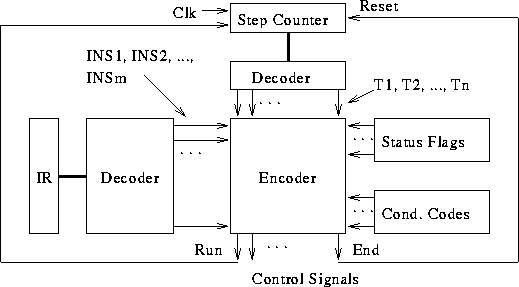
Tom Kelliher, CS26
Oct. 22, 1996
How does a computer look from ``underneath the covers?''
Fundamental internal CPU registers (not seen by programmer):
Two fundamental combinational circuits:

IR = (PC) and PC increment
PC = PC + 1. What is `` 1''?
Instruction or data.
MAR = (REGx), Read # 1 clock WMFC # ? clocks MDR = mem. data bus # 1 clock REGy = (MDR) # 1 clock
MAR = (REGx) # 1 clock MDR = (REGy), Assert write signal # 1 clock WMFC # ? clocks
Register file:
Assert address, load signal # 1 clock
Scalar register:
Assert load signal # 1 clock
Register file:
Assert address, read enable # 1 clock
Scalar register:
Assert read enable # 1 clock
Read enable?

Y = (REGx) BUS = (REGy), ALU-op, Z = ALUout REGz = Z
Adding 1?
Consider the execution of:
ADD (R3), R1
High-level execution sequence:
Detailed control sequencing:
1: PCout, MARin, Read, Clear Y, Set carry-in to ALU, Add, Zin 2: Zout, PCin, WMFC 3: MDRout, IRin 4: R3out, MARin, Read 5: R1out, Yin, WMFC 6: MDRout, Add, Zin Zout, R1in, END
Consider the execution of:
BR ENDIFAssume PC-relative addressing is used.
High-level execution sequence:
Detailed control sequencing:
1: PCout, MARin, Read, Clear Y, Set carry-in to ALU, Add, Zin 2: Zout, PCin, WMFC 3: MDRout, IRin 4: PCout, Yin 5: Offset-field-of-IRout, Add, Zin Zout, PCin, End
What about conditional branches?
Consider the execution of:
BZ ENDFOR
High-level execution sequence:
Detailed control sequencing:
1: PCout, MARin, Read, Clear Y, Set carry-in to ALU, Add, Zin 2: Zout, PCin, WMFC 3: MDRout, IRin 4: PCout, Yin, if Z = 0 then End 5: Offset-field-of-IRout, Add, Zin 6: Zout, PCin, End
Executing instruction requires executing sub-instructions. How is this controlled?
Two ways of designing CPU control:
What are the inputs to the controller?
Controller block diagram:

Some control equations:
PCout = T1 + ... MARin = T1 + T4*ADD*MEMORY_OPERAND + ... Zin = T1 + T6*ADD + T5*(BR + BZ) + ...
Asynchronous interface.
How does the CPU wait? What about the sub-cycle counter?
Refer to Fig. 3.11. For memory operations, need a circuit which:
Equations:
MR = Read + Readff Readff.set = Read Readff.reset = MFC MW = Write + Writeff Writeff.set = Write Writeff.reset = MFC Run = ~WMFC + MFC
1: PCout, MARin, Read, Clear Y, Set carry-in to ALU, Add, Zin 2: Zout, PCin, WMFC ...
MR + MW term in RUN.